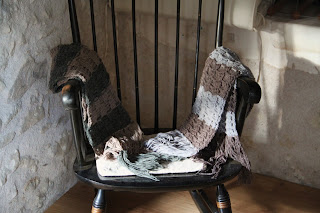 |
| Eleanor marrying the future Louis VII |
Anyway you look at it Eleanor of Aquitaine was a pretty impressive lady! At a time when women were seen as chattels of men she trod her own path with determination.
Heiress to, and then ruler in her own right of Aquitaine & Poitou, she married twice -- firstly to the French King Louis VII and then to Henry II of England. She participated in the 2nd Crusade [1145 - 49]. Two of her sons became kings of England: Richard the Lionheart and John Lackland. She also acted as regent for Richard while he was on the 3rd Crusade [1187 -92]. Her husband, Henry II placed her under house arrest for about 15 years for participating in her sons' [failed] rebellion against him.
Chroniclers of the time, even those who disapproved highly of her behaviour, decribe her as a very beautiful woman: tall, fair and blue eyed. Even in old age she continues to be described as such. She certainly was far too assertive for the men of the church:- Bernard of Clairvaux scolded her for her interference in matters of state. Born in either 1122 or 1124 she outlived all but her youngest son John and a daughter, dying in 1204 at 82, a very great age for the time.
By modern standars she had an eventful life; by those of the medieval period it was extraordinary. By rights, at the time, all that a women possessed became the property of her husband upon marriage. Effectively this meant that in Eleanor's case her domains of Aquitaine and Poitou were her husband's to rule. In practice, during her mariage to Henry II she ruled/administered her domains most of the time; although he did stick his oar in from time to time--mostly with infelicitous results. Aquitaine looked to Eleanor not Henry. These domains were vast and extremely attractive possessions. It is hardly surprizing therefore, that at 15 having recently inherited the Duchy of Aquitaine and become Countess of Poitou she was married to the future King Louis VII of France.
 |
| 1154: grey= English, pink= Royal French |
A quick glance at a map will show that the actual domains pertaining directly to the King of France were but a very small percentage of modern day France. Most of the land was held by others who acknowledged the King of France as their feudal overlord; but effectively these 'princes' ruled their own domains.
Eleanor had two daughters by Louis VII but the marriage wasn't a success. During the 2nd Crusade she very publicly disagreed with Louis regarding military strategy and sided with her uncle Raymond of Antioch who wanted to attack Aleppo. Louis imprisoned her for this opposition and headed off towards Jerusalem. She disagreed with Louis a second time about his intention to sack Damascus and was again imprisoned. The assault on Damascus was a failure and by the time the royal couple left Outremer to sail back to Rome and then travel on to Paris, Eleanor and her husband were on separate boats.
 |
| Eleanor and Henry side by side, Fontevraud |
After a bit of to-ing and fro-ing to obtain the necessary papal dispensation, the marriage was annulled in 1152. Louis was given custody of their two daughters and Eleanor's lands were returned to her. She headed immediately to Poitiers foiling 2 attempts, one by the Count of Blois and the other by the Count of Nantes, to kidnap her so as to marry her and claim her lands.
Once in Poitiers she wrote to Henry, Count of Anjou and Duke of Normandy asking him to come and marry her. It certainly wasn't customary for a woman to summon a prospective husband! They were married 8 weeks after her annulment; he was about 9 years her junior.
In 1154 Henry of Anjou became Henry II, King of England and Eleanor a queen for the second time. The marriage was probably stormy; Eleanor was strong willed and Henry II had the notorious Agevin temper which could, in extreme fits, leave him rolling on the floor foaming at the mouth in rage. However she bore him 8 children; the last John, in 1166.
 |
| Abbey church at Fontevraud |
By this time there were cracks in the relationship caused by Henry's infidelities and then Eleanor's support for her son Henry, the 'Young King' who, aggrieved by his lack of any power, rebelled against his father in March 1173. At the time Eleanor was in Poitiers ruling her domains but left them sometime that spring. She was arrested and taken to King Henry in Rouen. From then until Henry II's death at Chinon in 1189 she was kept in close house arrest in England. She was brought to court each Christmas as a gesture of seasonal goodwill by the King.
The 'Young King' had died of dysentry in 1183 during a second rebellion against his father. This left the second son, Richard to ascend the English throne on Henry II's death. He immediately gave orders for his mother's confinement to be lifted and Eleanor then went on to play a significant role during his reign, 1189 -1199.
 |
| tiny Isabelle next to brother-in-law Richard |
When she died in 1204, Eleanor was buried at L'Abbeye de Fontevraud beside her husband, Henry II; her son, King Richard I, 'the Lionheart'; and her daughter-in-law Isabella d'Angouleme, wife of her son King John. Their effigies can still be seen, although there are no graves. These were probably despoiled during the French Revolution.
An eventful life by anyone's standards! Alison Wier's
, Eleanor of Aquitaine, a Life (1999) is an excellent read if you wish to find out more.
Not far from Chinon Fontevraud, now restored and a cultural centre, is a wonderful place to visit.








































